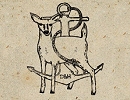Contact Seller
Doe And Hope
Tel07729 213013Please quote Antiques Atlas.


 17th Century / Earlier Indo-Persian Carving,c1600
17th Century / Earlier Indo-Persian Carving,c1600
 A PAIR of 17th/18th century carved oak panels
A PAIR of 17th/18th century carved oak panels
 Clock Wall Bracket
Clock Wall Bracket
 Antique Japanese Meiji period carved wood tiger
Antique Japanese Meiji period carved wood tiger
 A set of 10 hand carved Napoleonic soldiers C 1930
A set of 10 hand carved Napoleonic soldiers C 1930
 Canadian folk art carved maple Inuit figure group
Canadian folk art carved maple Inuit figure group
 Pair of Country oak primitive Carved statues 1780
Pair of Country oak primitive Carved statues 1780
 Very Tall Pair of African Marriage Figure Panels
Very Tall Pair of African Marriage Figure Panels
 Three Antique Oak Lions Mask Korbels.
Three Antique Oak Lions Mask Korbels.
 James I, Carved Oak Overmantle, England, C. 1603
James I, Carved Oak Overmantle, England, C. 1603
 19th Century Anglo-Indian / Burmese Wall Bracket
19th Century Anglo-Indian / Burmese Wall Bracket
 19th Century Carved Figure Saint Keys Of Heaven
19th Century Carved Figure Saint Keys Of Heaven
Non UK callers :
+44 7729 213013
Profusely Carved Anglo-Indian Bombay-Blackwood Urn


The hugely decorative, profusely carved and generously sized early to mid-nineteenth century Bombay blackwood centrepiece urn of Anglo-Indian origin, being campagna shaped, the bowl issuing acanthus leaves tapering to further naturalistic carving in the form of leaves and stylized berries, the circular socle base with gadrooning and stylized decoration, the underside carved as pineapple leaves, and the whole surviving from the second quarter of the nineteenth century.
The condition of the whole is relatively good. There are three sections of loss to note, which include two small leaves absent, some tips to the ancanthus leaves lost and some loss to the base. Overall approximately 90% of the carving remains in tact and she is very attractive in her entirety. There is a lovely patina present, particularly to the basin and issuing leaves.
The rich leaf work is reminiscent of similar work on Kashmir silver so it could be influenced from that region. This piece displays a level of craftsmanship and skill that is of a very high level, the whole carved profusely and it is not naïve or primitive and would have cost a large amount to commission at the time. It more thank likely acted as a centerpiece for a table either at banqueting or serving with it being able to hold flowers or fruits. We cannot find a comparable urn and it is likely it was made on commission for a wealthy westerner in India at the time.
The group of antique furniture termed ‘Bombay Blackwood’ was produced over a period of four decades from the mid-nineteenth century. Bombay Blackwood, is so called after the dark hues of Malabar teak and rosewood from which the furniture was made, was a rage among the city’s elite in the nineteenth and early twentieth centuries. The furniture was was of large scale so you needed equally as large estates to hold them. Whilst the designs were British, the craftsmen were predominantly Gujarati and Parsi immigrants from Surat and Ahmedabad many of them were experienced in shipbuilding, a major industry in Surat, and they were skilled carpenters.
Gradually the designs acquired locally flourished when artisans starting adding Indian touches such as elephants in their carving, which had previously only had typically British floral motifs and this led to Bombay Blackwood being exported to England and the US. The carved chairs, cabinets and antique tables became a rage in England after they were displayed at The Great Exhibition in 1851, an expo of design and technology from all over the world. After 100 years of Industrial Revolution, handmade objects appealed to the crowds greatly.
A rare object of huge quality and with its decorators scale it bears real showpiece winning style.
SellerDoe And Hope
View all stock from
Doe And Hope

 Private dealer, By appointment only
Private dealer, By appointment only
The Onion Barn, Shoe Cottage,
15 High Street, Blunham,
Bedfordshire, MK44 3NL.
MK44 3NL
Tel : 07729 213013
Non UK callers : +44 7729 213013
Get directions to Doe And Hope
The condition of the whole is relatively good. There are three sections of loss to note, which include two small leaves absent, some tips to the ancanthus leaves lost and some loss to the base. Overall approximately 90% of the carving remains in tact and she is very attractive in her entirety. There is a lovely patina present, particularly to the basin and issuing leaves.
The rich leaf work is reminiscent of similar work on Kashmir silver so it could be influenced from that region. This piece displays a level of craftsmanship and skill that is of a very high level, the whole carved profusely and it is not naïve or primitive and would have cost a large amount to commission at the time. It more thank likely acted as a centerpiece for a table either at banqueting or serving with it being able to hold flowers or fruits. We cannot find a comparable urn and it is likely it was made on commission for a wealthy westerner in India at the time.
The group of antique furniture termed ‘Bombay Blackwood’ was produced over a period of four decades from the mid-nineteenth century. Bombay Blackwood, is so called after the dark hues of Malabar teak and rosewood from which the furniture was made, was a rage among the city’s elite in the nineteenth and early twentieth centuries. The furniture was was of large scale so you needed equally as large estates to hold them. Whilst the designs were British, the craftsmen were predominantly Gujarati and Parsi immigrants from Surat and Ahmedabad many of them were experienced in shipbuilding, a major industry in Surat, and they were skilled carpenters.
Gradually the designs acquired locally flourished when artisans starting adding Indian touches such as elephants in their carving, which had previously only had typically British floral motifs and this led to Bombay Blackwood being exported to England and the US. The carved chairs, cabinets and antique tables became a rage in England after they were displayed at The Great Exhibition in 1851, an expo of design and technology from all over the world. After 100 years of Industrial Revolution, handmade objects appealed to the crowds greatly.
A rare object of huge quality and with its decorators scale it bears real showpiece winning style.
Price The price has been listed in British Pounds.
Conversion rates as of 16/APR/2025. Euro & Dollar prices will vary and should only be used as a guide.
Always confirm final price with dealer. Phone or visit the website to buy, Free UK shipping.
Category Antique Wood Carvings
Date c.1830-50
Mid 19th Century Antiques Material Black Stinkwood
Origin Indian
Item code as155a1483
Status Sold
£1600.00 
$2121.12 
€1863.36 

$

€

Conversion rates as of 16/APR/2025. Euro & Dollar prices will vary and should only be used as a guide.
Always confirm final price with dealer. Phone or visit the website to buy, Free UK shipping.
View all stock from
Doe And Hope

 Private dealer, By appointment only
Private dealer, By appointment onlyThe Onion Barn, Shoe Cottage,
15 High Street, Blunham,
Bedfordshire, MK44 3NL.
MK44 3NL
Tel : 07729 213013
Non UK callers : +44 7729 213013
Get directions to Doe And Hope
You may also be interested in
 17th Century / Earlier Indo-Persian Carving,c1600
17th Century / Earlier Indo-Persian Carving,c1600
 A PAIR of 17th/18th century carved oak panels
A PAIR of 17th/18th century carved oak panels
 Clock Wall Bracket
Clock Wall Bracket
 Antique Japanese Meiji period carved wood tiger
Antique Japanese Meiji period carved wood tiger
 A set of 10 hand carved Napoleonic soldiers C 1930
A set of 10 hand carved Napoleonic soldiers C 1930
 Canadian folk art carved maple Inuit figure group
Canadian folk art carved maple Inuit figure group
 Pair of Country oak primitive Carved statues 1780
Pair of Country oak primitive Carved statues 1780
 Very Tall Pair of African Marriage Figure Panels
Very Tall Pair of African Marriage Figure Panels
 Three Antique Oak Lions Mask Korbels.
Three Antique Oak Lions Mask Korbels.
 James I, Carved Oak Overmantle, England, C. 1603
James I, Carved Oak Overmantle, England, C. 1603
 19th Century Anglo-Indian / Burmese Wall Bracket
19th Century Anglo-Indian / Burmese Wall Bracket
 19th Century Carved Figure Saint Keys Of Heaven
19th Century Carved Figure Saint Keys Of Heaven







